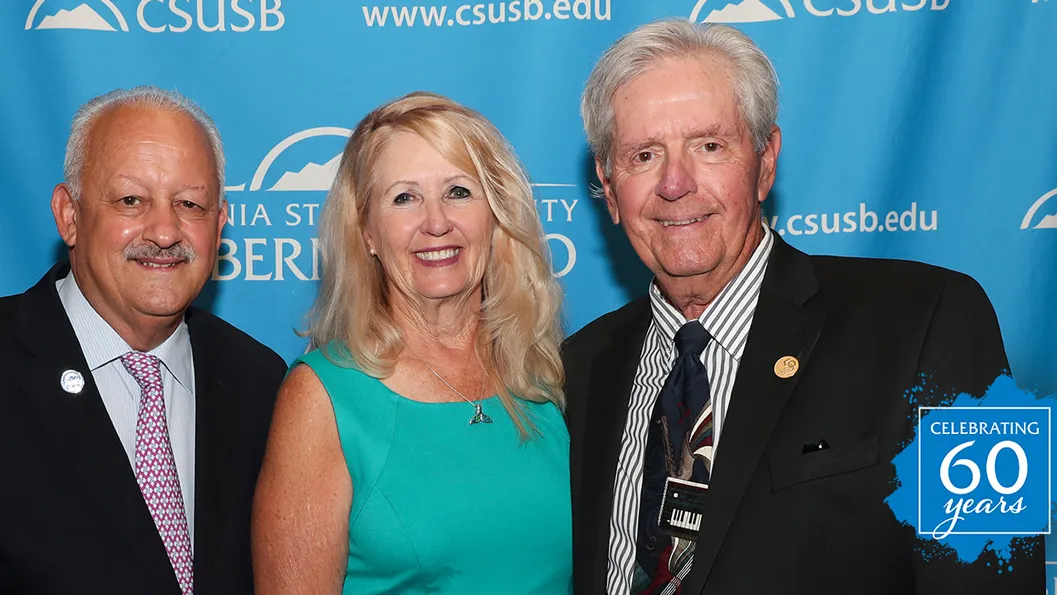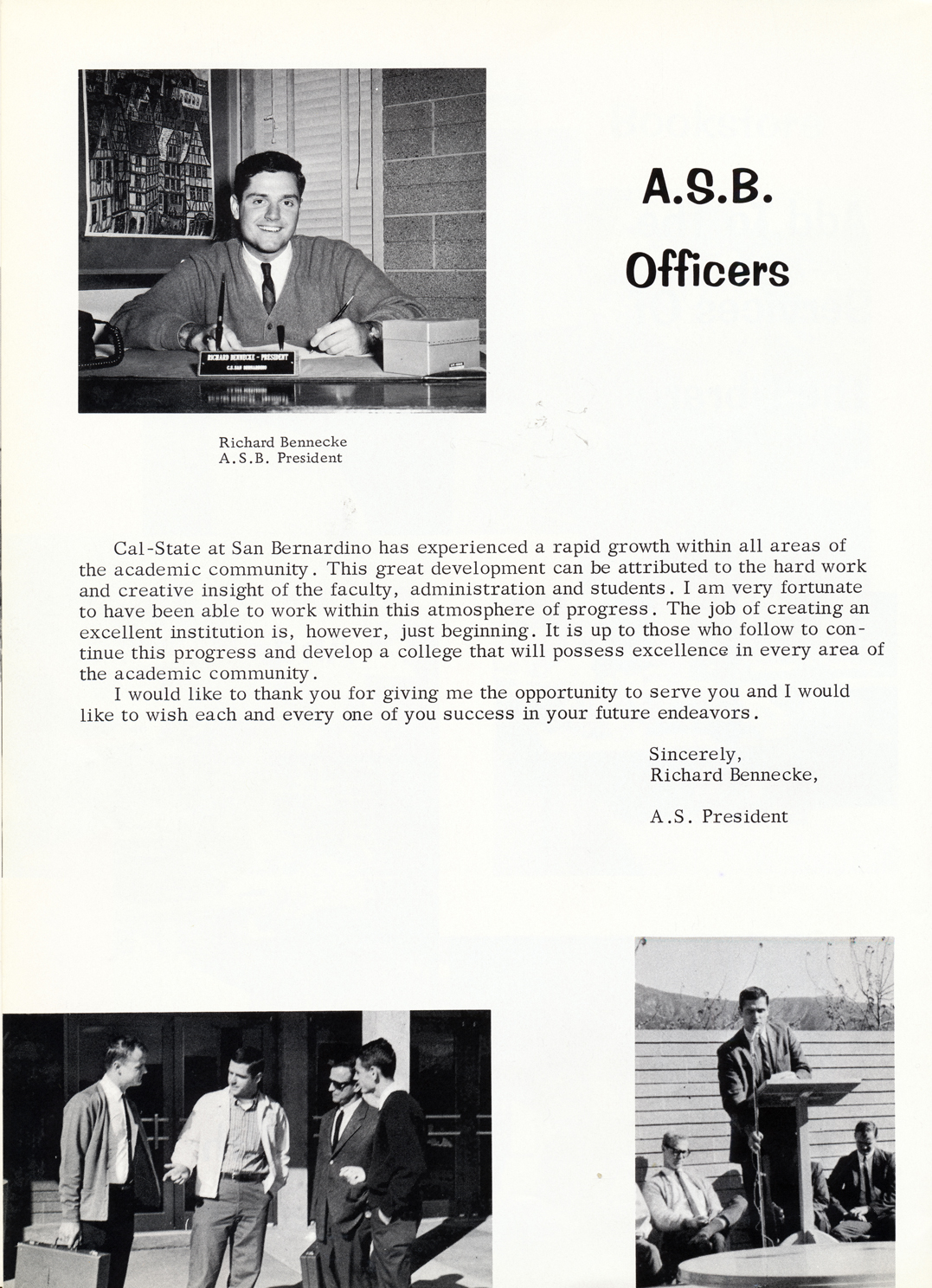Alan Llavore | Office of Marketing and Communications | (909) 537-5007 | allavore@csusb.edu

In the fall of 1965, Cal State San Bernardino opened with little more than a vision. The campus consisted of three concrete block buildings — a library, a classroom building and a building for offices — surrounded by acres of empty land. With only 293 students, there were no dorms, no student union, no traditions to carry forward. There were no formal athletic programs, just two ping-pong tables where students and faculty competed between classes.
For some, the future of this new college seemed uncertain. But for Richard and Linda Bennecke, it was the first of many opportunities to make a difference.
“I would love to be part of something that’s just getting off the ground,” Linda, a Redlands native, remembered thinking when she made the decision to attend San Bernardino State College. “I recognized it as a very historical moment that we were living and experiencing,” she said.
Richard, who had completed two years of college at the University of Redlands and was transferring to San Bernardino, agreed. “I thought, ‘What an experience. How many people get to witness and experience the birth of a college?’ I basically took a chance, and it was one of the best decisions I ever made in my life.”
Together, they built their lives alongside the growing institution. Richard, a political science major, became the college’s first student body president, worked to establish the foundation for student life and graduated in the first class in 1967.
Linda, who majored in sociology, worked as a campus tour guide and produced “The T Tauri,” the campus’s first historic publication. She was a member of the third graduating class in 1969, which included 14 first "pioneer graduates," so named because that they were the first to attend all four years at the fledgling college.
Their leadership roles on campus also carried into their careers. After his graduation, Richard became CSUSB’s Student Activities advisor, then the first director of the Student Union and later the first director of Alumni Affairs, while Linda remained deeply connected to the campus through student organizations and later professional and civic leadership.
“We worked together. We didn’t always agree, but we always worked it out,” Richard said. “Those became building blocks for our relationship and for the university.”

And while they hadn’t known one another in Redlands, it wasn’t long before their paths crossed through their student leadership roles. "Later we started the saying, and it probably is true today, ‘Meet your mate at SB State,’” Richard said with a laugh. Their first date was in April 1966 and they married in 1969. “They said it wouldn’t last," Linda said, smiling, “but look where we are now, 57 years later.”
In terms of the academic rigor the new college offered, “I actually likened it to a graduate program," Richard said. “Most of my classes had no more than maybe 12 students. A great majority of my professors were right out of Ph.D. programs with the latest, greatest information. Talk about an education; it was really fantastic.”
Yet in those early years, there were no established clubs, activities or social traditions, just students trying to build a campus culture from scratch. For Richard, as student body president, that meant taking on one of the toughest challenges: convincing fellow students to fund their own future.
“The whole idea was that we needed to create a college atmosphere,” he said. “We had to get a vote of the students to pass a fee, basically tax themselves. We thought, ‘If we don’t, this school may never get off the ground.’”
Linda noted that in addition to passing the student fee to fund the Associated Students Inc. (ASI), four committees were created, which included the publication, social, constitution and election committees. “We got our friends and acquaintances to work on these committees, and off we went.”
She also recognized a chance to record the genesis of the new college in real time. “I wasn’t a history major, but I recognized it as a very historical moment … that’s why I created ‘The T Tauri,’” a written record of the college’s background, which included information on the site selection, many firsts for the campus, and biographies of the first faculty members,” she said.
After graduating, Richard remained at CSUSB as an administrator for 17 years. Along the way, he also earned a master’s degree in public administration at the University of Southern California. He went on to serve five years as chief of staff for the San Bernardino mayor before launching a career with the U.S. Department of Defense implementing military base closures.
The importance of education became the cornerstone of their family life.
“Our main mantra was not ‘if’ you go to college, but ‘when’ you go to college,” Linda said. Richard, himself the first in his family to attend college, said the goal of a college education for their children “has been an integral part of our whole family culture.”
Once their children were in elementary school, Linda drew on her CSUSB experiences as she built a career in insurance and organizational leadership. “At Cal State, we had opportunities to do things we’d never done before personally,” she said. “The more challenges you take on and succeed at, the more you realize what you can accomplish.”
She began her long-term insurance career as a claims adjuster, later moved into the commercial field, and eventually rose through the ranks at AAA, where she became vice president of sales and marketing in AAA of Northern California. She later served as vice president of sales with the California Dental Association in Sacramento before retiring in southern California with Richard.
Since their student days at CSUSB, Richard and Linda raised three sons, all of whom attended CSUSB, and have six grandchildren, including one who graduated from CSUSB. For their family, the university has remained a touchstone across generations.
Looking back on six decades of growth at CSUSB, Richard reflected on how much has changed — and how much has stayed the same.
“The values of academic excellence and small class sizes have not changed in 60 years … those basics are still the same,” he said. “I’m very happy and pleased to have been a part of that whole process and part of the momentum that made this university the great university that it is today.
“I’ve always felt a special place in my heart for Cal State …,” he added. “I was given opportunities there that I would not have had at another campus. For that, I’m forever grateful, and I will always support the university.”